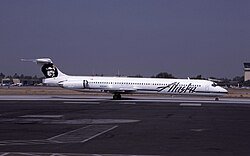On January 31, 2000, the world was shaken by a tragic event – the crash of Alaska Airlines Flight 261. This McDonnell Douglas MD-83 aircraft was en route from Puerto Vallarta, Mexico, to San Francisco and Seattle when it tragically crashed into the Pacific Ocean off the coast of California. The crash claimed the lives of all 88 individuals onboard, leaving a lasting impact on the aviation industry.
The investigation that followed revealed that the crash was a result of a catastrophic failure of the aircraft’s horizontal stabilizer. This failure was attributed to insufficient maintenance and lubrication, highlighting the importance of proper maintenance and adherence to safety protocols in the aviation industry.
The National Transportation Safety Board (NTSB) conducted a comprehensive investigation into the incident. Their findings shed light on the factors that contributed to the tragedy and led to significant changes in aviation safety protocols and maintenance procedures for the MD-83 fleet.
The crash of Alaska Airlines Flight 261 served as a wake-up call for the aviation industry. It highlighted the need for improved maintenance practices and stricter adherence to safety regulations. As a result, airlines and regulatory authorities around the world implemented measures to prevent similar incidents from occurring in the future.
The NTSB investigation revealed that the crash was caused by a failure of the jackscrew assembly in the aircraft’s horizontal stabilizer. The jackscrew, a critical component responsible for controlling the aircraft’s pitch, had suffered excessive wear and damage due to inadequate lubrication. This led to a loss of control and ultimately resulted in the aircraft’s descent into the ocean.
Following the investigation, the NTSB made several recommendations to enhance aviation safety. These included improved inspection procedures for jackscrews, enhanced training for maintenance personnel, and the development of better lubrication and maintenance standards for the MD-83 fleet.
The tragedy of Alaska Airlines Flight 261 also prompted a reevaluation of the relationship between airlines and aircraft manufacturers. It raised questions about the responsibility of manufacturers to ensure the safety and reliability of their products throughout their lifespan. This incident led to discussions about the need for increased oversight and collaboration between airlines, manufacturers, and regulatory authorities.
Today, the legacy of Alaska Airlines Flight 261 lives on through the lessons learned and the changes implemented in the aviation industry. The tragedy served as a catalyst for improvements in aircraft maintenance practices, safety protocols, and the overall culture of safety within the industry.
As we remember the lives lost on that fateful day, it is essential to reflect on the progress made in aviation safety since then. The industry continues to evolve, with ongoing efforts to enhance safety standards and prevent future tragedies.
It is crucial to honor the memory of the victims of Alaska Airlines Flight 261 by ensuring that their loss was not in vain. The lessons learned from this tragedy continue to shape the aviation industry, making air travel safer for all passengers.
For more information about the Alaska Airlines Flight 261 tragedy, you can refer to the following external references:
- NTSB Accident Report – Alaska Airlines Flight 261
- Alaska Airlines – Flight 261
- FAA – Alaska Airlines Flight 261
Remembering the tragic events of January 31, 2000, serves as a reminder of the importance of safety in aviation and the continuous efforts to prevent such incidents from happening again. Let us honor the memory of those who lost their lives by striving for a safer future in air travel.

